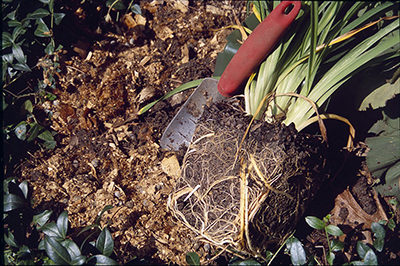Bare root plants provide opportunities for early spring planting
Bare root perennials feature several advantages for gardeners over container-grown plants.

Michigan gardeners carefully await their local frost-free dates to plant colorful perennials in the garden. For some of us, this seems like forever.
Garden center shelves are packed with lush green plants that have been grown in climate controlled greenhouses through the winter months. With varying frost-free dates throughout Michigan, gardeners can be frustrated when a late spring frost blackens the foliage. It is always best to check out your local frost-free date before you succumb to the temptation to “green up” your garden too early.
Many plants can be purchased as dormant or “bare root” specimens, which offer several advantages for gardeners wanting to get out and plant early. Field grown perennials are dug in the fall once the plants begin to harden off for winter. Growing in the field allows root systems to be robust and well developed. These bare-root plants are held in cold storage until you purchase them. As soon as your garden soil is warm enough to be worked in spring and not too soggy, you can plant these plants without fear of frost. Fully dormant, bare root perennials will wake up naturally with the oncoming spring temperatures. They will quickly acclimate to your soil type and growing environment—and are never jeopardized by excess organic media left on the root ball.

Container-grown plants are often root bound and have organic media in the root ball.
Planting a bare root plant is easy. Care should be taken to situate the plant in a hole wide enough to have its roots fanning out in the same fashion it was in the field. In addition, it should be somewhat evident how deep to plant based upon the soil line on the dormant plants. If you can’t tell this, make sure the buds are perched right at soil level and not buried deeply unless the directions instruct for this. Press in gently and allow for settling. Many perennials benefit by having a light layer of mulch or compost positioned in a ring around the crowns.
It is best to plant your bare root plants as soon as you purchase them to avoid drying out. If you cannot get them in the garden right away, consider heeling in the plants in a large pot with container media. Keep them moist but not soggy until you are ready. On occasion, mail order plants may come somewhat shriveled and dry. For the most part, this is only a minor setback. Simply soak the plants in water for a couple of hours prior to planting to make sure they are fully turgid and they should acclimate just fine.
Michigan State University Extension is offering a free class as part of the 2017 Bare Root Plant Sale Saturday, April 22, 2017 at 10:30 a.m. at the Kent County MSU Extension office to learn more about selecting and using bare root perennials. A nice selection of bare root plants is also being sold to support the MSU Extension Grand Ideas Garden.
During this class, you will also learn how to force tender tropical perennials indoors before their dramatic foliage comes alive in the summer months. The class will also explore a rich pallet of perennials to add interest, seasonal color and pollinator resources in your perennial garden. To register, go to 2017 Bare Root Plant Sale.



 Print
Print Email
Email




